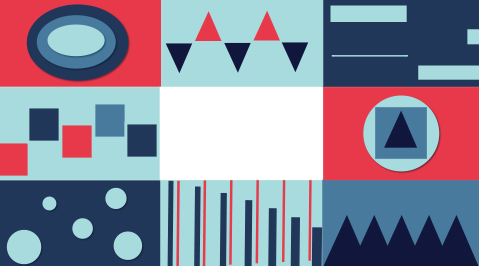Reflection is an essential development strategy, particularly in design practice, as it is the process through “which the client and design agency might seek to identify what worked well and where there is room for improvement” (Ambrose, G, & Harris, P 2009, p.29).
I thoroughly enjoyed my exploration of Adobe After Effects and the opportunity to develop a short abstract piece. Initially I found the program cumbersome and hence got off to a slow start, but persistence paid off in the form of newfound skills. When examining the final product, I feel that it reflects thought and consideration in a variety of motion fundamentals (Krasner, J 2013) that underpinned my work.

Initially, I sought to utilise a series of primary object movements by simply creating basic shapes and enabling them to move, using the position and anchor point tools. The use of primary object movement in my final piece is a significant extension on my earlier experimentation. I feel that I gained quite an established handle on this particular motion design fundamental. I was also able to include primary movement when fading objects in and out in order to build the composition and enhance the final product.
In developing my work, I also considered how real-life motion occurs, whether human or inanimate. By understanding the way in these secondary camera motions capture movement, allowed me to explore ways of zooming or adjusting perspective. The moving lines in the bottom middle rectangle, mimic the movements of a gate by adjusting the scale in order to capture this movement. The final rectangle that consumes the screen, also represents a ‘zoom’ camera function. Understanding secondary motion also allowed me to delve into how, “Physics-based simulation is a natural choice for creating secondary motion effects” (Hahn et al. p.2).
A crucial part of motion design is considering timing. Being able to execute a refined motion design, is also dependant on your understanding of temporal elements and the way in which objects speed-up or slow-down. This aspect was something that I developed later in the project as I found that I was either developing movements too fast or too slow and this greatly impacted the busy feel of the piece. By adjusting how fast or slow something moves can enhance the response or the emotion that is evoked. The movements displayed in my final piece explore timing in alignment with the music to create a sense of rhythm and cohesion.

I will gladly admit that I am a full-blown newbie to this program and therefore the level of technical achievement may not sit as high as I would like to achieve moving forward. I feel I have got a good handle on the primary motion and the basic ‘transform’ functions available in the layers, allowing me to apply some level of motion design fundamentals from each of the three cores. The final motion design piece reflects an abstract aesthetic and doesn’t necessarily convey a narrative. The colour palette in my final design also showed greater consideration as opposed to my earlier piece.


If I were to break down this explorative motion design experience into three key moments, I would identify as follows…
- Layers, Layers, Layers!
While I wanted my motion design piece to demonstrate motion complexity, this quickly led to an abundance of messy layers.
I learnt quite early on, that labelling these layers and even breaking down sections of movement into individual ‘compositions’ was an essential coping mechanism. In doing this, I was able to compartmentalise my various motion experiments allowing more control in picking and choosing which of the experiments would constitute my final design.


- Yes, this is an experiment- but don’t make it look like one!
While I was in, “that playful phase of seeking out forms inspired by content and seeking out limitations in tools and perspectives…” (Lupton, E 2011, p.178), I was also aware that the final design needed to have some level of curation. My initial draft felt slightly disjointed and basic, so in order to progress I decided to conduct some more research. Some pieces that I found during this process included, ‘I ❤ Camping’ by Monologue and George Zestanakis, ‘Be Work Happy’ by WeAreFormation and ‘Flight Pattern’ by Gwen Vanhee.

- Design meets physics
Another discovery I have made is the importance of understanding movement and being able to merge that with design. Initially I found the different tools and functions daunting and had grand design plans but had no idea how to execute them. As I experimented, I found that it all came down to understanding the illusion of movement, simply by applying a variety of movement fundamentals.

When reflecting on the skills I have acquired, I hope to progress further in exploring how I can create more realistic animations as opposed to basic shapes. I hope to gain more experience in temporal aspects to create sophisticated animations. After this first interaction with motion design, I feel that I have had a taste of the breadth and depth of consideration that goes into creating a quality motion design piece (even a short one!).
Perhaps a motion design with more of an educational narrative could be my next endeavour?
References:
Rajagopalan, A.N & Chellappa, R 2014, Motion Deblurring: Algorithms and Systems, Cambridge University Press
Ambrose, G, & Harris, P 2009, Design Thinking, AVA Publishing, Crans-pres-Celigny, CHE.
Lupton, E 2011, Graphic Design Thinking : Beyond Brainstorming, Princeton Architectural Press, New York.
Joost, G, Bredies, K, Christensen, M, Conradi, F, & Unteidig, A 2016, Design As Research : Positions, Arguments, Perspectives, Walter de Gruyter GmbH, Basel/Berlin/Boston.
Hahn, F, Thomaszewski, B, Coros, S, Sumner, R.W, Gross, M & Zurich, E.T.H, ‘Efficient Simulation of Secondary Motion in Rig-Space’, Disney Research Zurich, pp. 1-7
Krasner, J 2013, Motion Graphic Design : Applied History and Aesthetics, Routledge, Oxford







